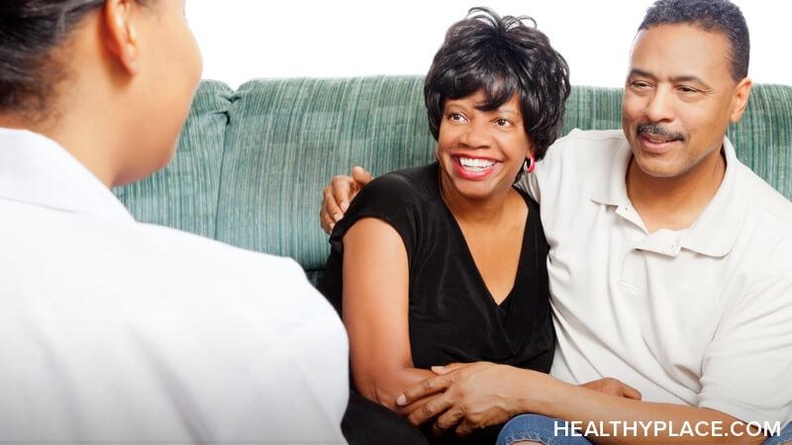How to Find a Good Marriage Counselor

Your marriage is in trouble and you need a good marriage counselor. Here's how to find one and what to expect out of marriage counseling.
Edited from a chapter in 5 Steps to Romantic Love.
The information described on this page will assist you in finding a good marriage counselor.
How to Make Your First Appointment
What to Expect In Your First Session (Intake)
What to Expect In Your Second Session (Assessment)
Introduction to Marriage Counseling from a Marriage Counselor
My books and articles provide you with methods and tools that have proven useful to me in saving marriages. But even the best concepts and forms in the world won't help under certain conditions. Sometimes you need the support and motivation that only a professional marriage counselor can provide.
The purpose of a marriage counselor, from my perspective, is to guide you through (1) emotional minefields, (2) motivational swamps and (3) creative wildernesses.
The emotional minefields represent the predictable, yet overwhelmingly painful experiences that many couples go through as they try to adjust to each other's emotional reactions. Hurt feelings are the most common, but depression, anger, panic, paranoia, and many others seem to pop up without warning. These emotions distract couples from their goal of creating romantic love and often sabotage the entire effort.
A good marriage counselor helps couples avoid many of these emotional landmines and is there for damage control when they're triggered. He/she does this by understanding the enormous stress couples are under as they are facing one of their greatest crises. When one or both spouses become emotionally upset, he/she has the skill to diagnose and treat the emotional reactions effectively. I counsel with a psychiatrist who prescribes psychotropic medication (anti-anxiety and anti-depressants) to alleviate the emotional pain that often accompanies the process of marital adjustment. A good counselor knows how to calm the couple down and assure them that their emotional reactions are not a sign of hopeless incompatibility.
The motivational swamps represent the feeling of discouragement that most couples experience. They often feel that any effort to improve their marriage is a waste of time. Over the years, I believe that one of my greatest contribution to couples has been my encouragement when things looked bleak. My clients knew that at least their counselor believed that their effort would be successful. Eventually, each spouse would come to believe it too.
Discouragement is contagious. When one spouse is discouraged, the other quickly follows. Encouragement, on the other hand, is often met with skepticism by the other spouse. So its easy to be discouraged, and difficult to be encouraged, when you are trying to solve marital problems. A marriage counselor should be there to provide needed encouragement when there's none other in sight.
The creative wilderness represents the typical inability of couples in marital crisis to create solutions to their problems. In the books I've written, many solutions are suggested but they're only the tip of the iceberg. Many marital problems require solutions that are unique to certain circumstances. In this site, I put more emphasis on the process you should follow to solve marital problems than I do on the specific strategy you should use. That's because there are too many situations that require unique strategies.
A good marriage counselor is a good strategy resource. While you can, and should, also think of ways to solve your marital problems, a marriage counselor should know how to solve problems like yours. That's what you pay him/her to do! And his strategy should make sense to you. In fact, his strategy should encourage you in the belief that your problems will be over soon. Counselors often obtain special training for many common marital problems, such as sexual incompatibility and financial conflicts. These counselors can document a high rate of success in finding solutions to those problems.
To summarize, the three most important reasons to find a marriage counselor are (1) to help you avoid or overcome painful emotional reactions to the process of solving marital problems, (2) to motivate you to complete your plan to restore romantic love to your marriage, and (3) to help you think of strategies that will achieve your goal.
If you can handle your emotional reactions, provide your own motivation and can think of appropriate strategies, you don't need a marriage counselor. In fact, I suggest that you try solving your problem on your own until you hit a roadblock. But if your efforts hit a snag, find a professional marriage counselor to help you. Marital problems are too dangerous to ignore, and their solutions are too important to overlook.
How to Make Your First Appointment with a Marriage Counselor
The yellow pages is probably one of the most common places to discover where to find marriage counselors. Your physician or minister may also be able make suggestions. But the most reliable sources of referral are people who have already seen a counselor that has successfully guided them to romantic love. Since couples are usually tight-lipped about their marital problems, that kind of referral is usually difficult to obtain.
Regardless of your source of referral, however, you should take steps to be certain that you select someone who can help you. And remember, the counselor who can help your marriage helps both you and your spouse. If at all possible, make sure your spouse is an active participant in this selection process.
Begin by calling one clinic at a time, asking the receptionist to speak to the counselor you are considering by telephone. There should be no charge for this preliminary interview. You should ask the counselor some of the following questions:
- How many years have you been a counselor?
- What are your credentials (e.g. academic degree)?
- Do you help your clients avoid some of the emotional hazards of marital adjustment?
- Do you help motivate your clients to complete the program successfully?
- Do you suggest strategies to solve your clients' marital problems?
You may wish to add other relevant questions. You may also try to let the counselor know what type of marital problem you have. After going through this site, you'll probably have more insight regarding your problem than counselors are accustomed to hearing. Use that insight to discover if the counselor has the background and skill to help you with your particular problem.
I would highly recommend that you ask if the counselor is presently using my books, His Needs, Her Need, and Love Busters. If they are not using these books, ask if they'd be willing to use them when counseling with you. While this may seem like a marketing ploy on my part, the reason I would like you to take my materials with you is that I'd like you to stick to the program I've recommended. There are many ineffective marriage counseling methods being used these days and I think you'd be more comfortable with a counselor who uses my direct method of dealing with the problem. Counselors that only sit and listen to couples complain should be avoided at all costs!
Most couples who see me are in a state of crisis. They don't go to the trouble and expense of marriage counseling for marriage "enrichment." They are facing marital disaster! With that in mind, time is of the essence. You cannot wait weeks for your first appointment. In fact, you should probably be seen the same day you call.
After speaking to several marriage counselors on the telephone, and taking good notes on their answers to your questions, try to narrow your choice to three counselors. Keep all your notes, since the first one you select may not work out.
When you and your spouse both feel comfortable with a particular counselor, set up your first appointment.
What Is the Cost of Marriage Counseling?
Cost varies widely among marriage counselors. But before we talk about cost, I strongly advise you against counselors that cannot see you soon and often. That rules out most Health Maintenance Organizations which are free or low cost because their overworked counselors are usually weeks away from taking new couples, and they tend to schedule follow-up appointments weeks apart. Furthermore, their counselors are not likely to talk to you on the telephone prior to an appointment.
Insurance generally will not pay for marriage counseling unless the counselor finds you or your spouse suffering from a mental disorder. Marriage counseling is covered as treatment for the disorder, but not otherwise. If you see a counselor who uses your insurance, you can be almost certain that you've been diagnosed to have a mental disorder. It'll be on your record for years to come and may prevent you from obtaining certain jobs or qualifying for certain types of insurance. Furthermore, if you really do not have a mental disorder, but it's been diagnosed just to collect insurance, your insurance company may challenge the diagnosis leaving you responsible for the bill. If you're offered counseling for what your insurance pays with no other cost to you, its illegal. Call your insurance company or your state's insurance commissioner to report the attempt to commit insurance fraud.
It's safe to assume that you may need to pay for therapy out of your pocket. So how much do marriage counselors charge? Rates vary from about $45 to $200 per session. The average is about $95. Since most marriage counselors see couples one session a week for the first three months, you can expect to pay about $1200 in that period of time if it's at about $95/hr. Most of my clients have paid under $1200 by the time they've completed therapy. But some counseling can continue weekly for as long as two years before the problems have been resolved. That would cost a couple $10,000 over two years. While it may seem like a fortune, the cost of divorce is often many times that figure.
To help put the cost of marriage counseling in perspective, there's nothing you can buy for $10,000 that will give you the same quality of life that a healthy marriage provides. If you and your spouse love each other and meet each other's important emotional needs, you'll be able to do without many other things and still be happier in the end. Besides, I've found that people seem to earn more and save more after their marital problems are solved. The money you spend to resolve your marital problems is money well spent.
What to Expect In the First Marriage Counseling Session (Intake)
If you see a counselor in a clinic or suite of counseling offices, a receptionist should be present and the waiting room should be pleasant and relaxing. You should register at the desk when you arrive and you'll be asked to complete registration forms and contracts. Read them carefully. You may also be asked to complete insurance forms.
Most "hour" sessions are actually forty-five minutes. Fifteen minutes are taken by the counselor to complete notes and prepare for the next session. While I've always tried to time my sessions carefully, I try to be flexible and considerate at the end of each hour. Sometimes I find myself giving a couple an extra fifteen minutes to pull themselves together, putting me fifteen minutes behind for my next couple. The extra fifteen minutes between sessions helps me catch up when I'm running behind.
Punctuality is very important. While most counselors will sometimes run about half an hour late, it should not be a pattern. Your time is important, and you shouldn't be expected to waste it waiting for your counselor. Complain if it becomes a problem.
Most marriage counselors see couples together in the first session, but I do not. Instead, I see each person separately for fifteen minutes so that I can gain their individual perspectives. Besides, I've seen too many fights break out when I see couples together for the first time. For your own comfort and security, I recommend that you see your counselor separately, at least briefly, during the first session.
The purpose of the first session is to familiarize yourself with the counselor. He has almost no opportunity to discover how to solve your problem at that point, but you can often determine your comfort and confidence in him/her. If you or your spouse react negatively to his/her style, find another counselor. He/she is there to inspire you and if he/she doesn't do that, you'll be wasting your time.
The counselor will ask you why you've come to see him/her, and you should answer that you've come for help in restoring love to your marriage. When you're asked to be more specific, you explain that you've both developed habits that hurt each other more than they help each other, and that you want to develop more constructive habits. You want to learn to meet each other's needs and avoid being the cause of each other's unhappiness. You go on to explain that you want him/her to help you achieve that goal.
At the end of the session, you're seen together and asked to complete forms so that he/she can evaluate your marital problem. I use my Love Busters Inventory (LBI), my Emotional Needs Questionnaire (ENQ) and a test of romantic love.
The LBI and ENQ are available to you in this site. If the counselor does not use these forms for his evaluation, you may suggest providing them to him to help determine your goals.
I usually try to schedule the second appointment for no more than a week later. If possible, I try to see the couple within a few days. This is because they are usually suffering from their problems and would like relief as soon as possible. I can't give them any advice after the first session because I don't know much yet. The advice comes after I've had a chance to review the forms they complete.
What to Expect In the Second Session of Marriage Counseling (Assessment)
The purpose of the second session is to review the forms you've completed and plan a strategy to resolve your marital problems. It's usually impossible to do this in one hour so you should expect this strategy session to take two.
You and your spouse should be seen alone again for at least part of the session. As your counselor suggests his/her plan, you need to be able to react honestly and the presence of your spouse may inhibit your reaction. At the end of the session, however, you should be together to formally agree to a plan which is carefully described in writing.
There's no point to treatment before a treatment plan is completed. Poorly organized counselors will often see clients for weeks before they get down to deciding how they'll proceed. During that time, the crisis is over and the motivation to solve the problem is postponed until the next crisis. The couple drops out of therapy no wiser or better off than they came. To avoid that tragic end, a counselor must focus on a treatment plan immediately, while the couple is still motivated to do something about their problem.
If your counselor claims to need several sessions before arriving at a treatment plan, resist it. Explain that even if the initial plan needs to be revised during treatment, its better to begin with some plan than no plan at all. Not only do you want to get on with it, but there's also a big risk that you or your spouse will lose motivation before the plan is completed. Most couples that come for marriage counseling need plenty of encouragement from the first session on, and its discouraging to wait for a treatment plan.
At the end of the second session, you should not only know the treatment plan, but you should also be given your first assignment. The value of marriage counseling is in what you achieve between sessions, not necessarily what you achieve during the session.
One of your first assignments should be to document the prescribed hours you spend giving each other undivided attention. Most of your other assignments will be carried out during those hours. The time you set aside for each other must be carefully guarded. Its easy to let the emergencies of life crowd out your time together, leaving you without time to solve your marital problems.
You may be able to carry out the treatment plan on your own. Perhaps all you want is professional advice regarding a strategy that will help you solve the problem. If emotional minefields and motivational swamps are not a threat to your marriage, you may find that the counselor's experience helped you think of a solution that you would not have found by yourself. If that's the case, I would recommend you set one more appointment in a week or two to guarantee that you are carrying out the plan without any need for further help. But be sure to come back if you're not making progress.
What to Expect During Treatment for Marital Problems
From the third session on, you're guided by the treatment plan that you agreed to follow. Each week you report your successes and failure to the counselor. He/she guides you through the emotional minefields, motivational swamps and creative wildernesses. If your counselor is right for you, you'll come to like and respect him/her more and more as time goes by. You'll see your marriage improve in fits and starts. Some weeks will be blissful while others will be unbearable.
Its common for couples to experience a crisis between appointments that requires a counselor's mediation. I've usually been willing to have couples call me at the office or at home for emergencies because I realize that I'm working with couples in crisis. Sometimes a call is simply for clarification of an assignment. But I've also had threats of suicide, violent arguments and irresponsible browbeatings that need to be dealt with at the time they occur. If I get too many calls from a couple, I schedule their appointments closer together.
Both you and your spouse should be the judge of your need for continued treatment and when to terminate treatment. I usually use the success of the treatment plan to determine how to phase clients out over time. I will see them once a week in the beginning, twice a month after they are on a steady course, and once a month when they are nearing the end. Its not uncommon for couples to return after six months or a year just to check on their status.
Men generally want to get out of therapy as soon as possible, even when they were the ones that wanted it the most in the beginning. They don't like the idea of reporting to someone regarding their behavior, and my role as a counselor is to see to it that they follow through on what they promised. They often agree to anything to get their wives back, and then once she's home, they go back to their old habits.
With that type of problem in mind, don't abandon therapy unless you both enthusiastically agree to do so. If one of you wants to keep the door open, reschedule once a month or less often just in case problems arise. In the end, you and your spouse will be very much in love with each other. I have couples repeat my test for romantic love every few weeks so I can be certain we're on the right track. You might want to do something similar to measure the success of your program. But when you're in love, you don't really need a test to prove it!
About the author: Willard F. Harley, Jr., Ph.D. is best known as author of the internationally best selling book, His Needs, Her Needs: Building An Affair-proof Marriage. Dr. Harley is the founder of Marriage Builders, a marital therapy program designed to save marriages.
APA Reference
Staff, H.
(2021, December 18). How to Find a Good Marriage Counselor, HealthyPlace. Retrieved
on 2025, October 28 from https://www.healthyplace.com/relationships/therapy/how-to-find-a-good-marriage-counselor




